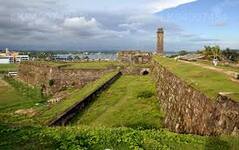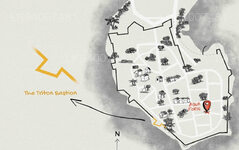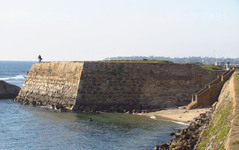
Galle City
Galle, a charming coastal city in Sri Lanka, boasts a rich history and vibrant culture. Its iconic Dutch Fort, a UNESCO World Heritage Site, stands as a testament to colonial influence. Explore pristine beaches, immerse in cultural festivals, and savor local cuisine amidst the old-world charm of Galle.
Trion-Bastion



Die Triton-Bastion, die während der Herrschaft des niederländischen Gouverneurs Vuyst zu Beginn des 18. Jahrhunderts erbaut wurde, war eine Verstärkung der bestehenden Ufermauer in der südlichen Kolonialstadt Galle . Zur Verteidigung war es mit acht Geschützen ausgestattet. Seit der Eintragung in die Liste des Weltkulturerbes der UNESCO hat die Stätte von einem umfassenden Sanierungsprogramm profitiert und sieht heute fast genauso aus wie zur Kolonialzeit. Es überlebte sogar den Tsunami von 2004. Die Triton-Bastion wurde zuvor als Mühle für Meerwasser genutzt, das dann zur Staubreduzierung auf den Straßen der Stadt eingesetzt wurde.
Es ist einer der besten Orte, um den Sonnenuntergang zu beobachten, obwohl es in der Nähe auch mehrere Bars und Restaurants gibt, die es Ihnen ermöglichen, von ihren Balkonen aus das Gleiche zu tun und etwas zu trinken.
About Galle District
Galle is a city situated on the southwestern tip of Sri Lanka, 119 km from Colombo.Galle is the best example of a fortified city built by Europeans in south and Southeast Asia, showing the interaction between European architectural styles and south Asian traditions. The Galle fort is a world heritage site and the largest remaining fortress in Asia built by European occupiers.
Galle is a sizeable town, by Sri Lankan standards, and has a population of 91,000, the majority of whom are of Sinhalese ethnicity. There is also a large Sri Lankan Moor minority, particularly in the fort area, which descend from Arab merchants that settled in the ancient port of Galle.
About Southern Province
The Southern Province of Sri Lanka is a small geographic area consisting of the districts of Galle, Matara and Hambantota. Subsistence farming and fishing is the main source of income for the vast majority of the people of this region.
Important landmarks of the Southern Province include the wildlife sanctuaries of the Yala and Udawalawe National Parks, the holy city of Kataragama, and the ancient cities of Tissamaharama, Kirinda and Galle. (Although Galle is an ancient city, almost nothing survives from before the Portuguese invasion.) During the Portuguese period there were two famous Sinhalese poets called Andare who was from Dickwella and Gajaman Nona who was from Denipitiya in Matara District, composing poems on common man.


















